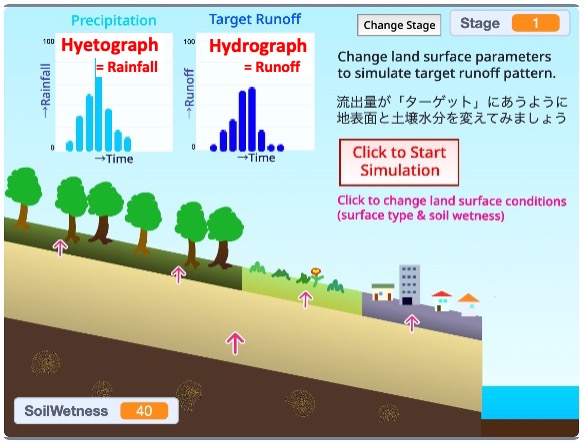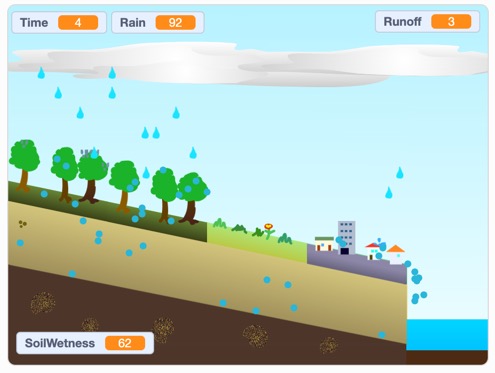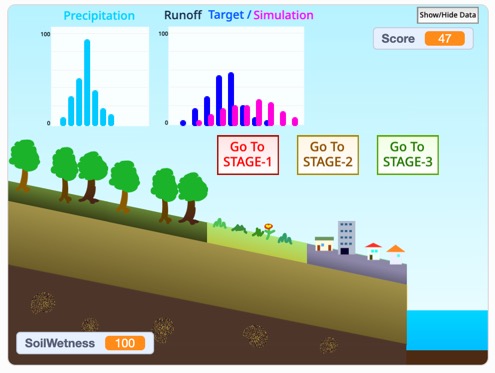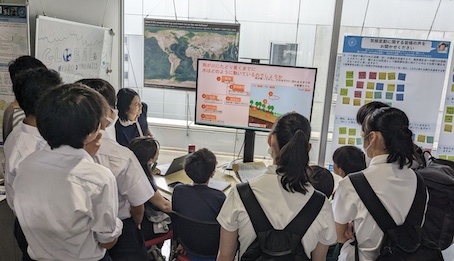SplashTune!
(Scratch-based PLAyble Simulator for Hydrograph Tuning)
Learn hydrological processes through a game!
The mechanisms of water dynamics through rainfall on land to water runoff to rivers is called rainfall-runoff process. We have created “SplashTune” a rainfall-runoff modeling game that allows you to enjoyably learn this process through simulation.
Please change the surface conditions of the rainfall-runoff model and match the simulated runoff patterns to the “targets” runoff pattern.
Let’s learn about the rainfall-runoff process through playing the game. Press the green flag button to start the game.
SplashTune (v2.3)
Access to source code on Scratch webpage: https://scratch.mit.edu/projects/1194996537
Rules and How to Play
1. Game Objective
The game represents various processes through rainfall in the river basin to runoff as the movement of water particles in animation.
- When you start the game, the time variation of precipitation is displayed as a light blue graph. During the simulation, rain fall happens following the intensity shown in this graph.
- When the rain reaches the ground, it becomes water particles and moves on land. The movement of water particles is influenced by the state of the land surface.
- When water particles reach the river, it becomes runoff. The goal of the game is to adjust the surface conditions to make the simulated runoff time variation similar to the target graph shown in blue.
Note: The time variation graph of precipitation is called “Hyetograph,” and the time variation graph of runoff is called “Hydrograph.”

2. Setting Land Surface Conditions
Before starting the simulation, you can change the land surface parts indicated by the pink arrows in the screen by clicking (or tapping).
- You can change the land surface type of the 2 locations from upstream to downstream (4 locations after stage 5). You can choose from three land types: forest, grassland, and urban area. The movement of water particles varies for each type.
- You can also change the initial state of soil wetness. 0 represents a dry soil condition, and 100 represents a completely wet and saturated soil condition. The soil wetness influences the movement of water particle.
Compare the hyetograph and hydrograph and try to find optimal land surface conditions to get a high score.
3. Running the Simulation
After setting the land surface conditions, Click “Start Simulation” button to start the simulation.
During the simulation, you cannot make any changes, so observe how water particles move.
- Some of the rainfall does not contribute to runoff and becomes rainfall loss due to evaporation and transpiration.
- Some of the water particles that reach the ground flow on the land surface, while others infiltrate into the ground.
- In the subsurface, water particles move slowly, and some are absorbed by the soil.

4. Simulation Results and Score
The time series data of the simulated runoff amount is displayed as a pink graph.
The score is calculated based on the similarity between the simulated runoff amount and the target runoff amount shown in blue. The highest score is 100 points.
Analyze the differences between the target and simulation, adjust the surface conditions through trial and error. Aim for a score of 90 or higher. Perfect score is 100!.

5. Stage Selection
You can try many stages with different patterns of rainfall and target runoff patterns. Aim for 90 points or higher score in each stage. Please consider how surface type and soil moisture affect the rainfall-runoff process.
- Why does urbanization enhances floods?
- How does the movement of water differ in urban areas, grasslands, and forests?
- What impact does afforestation have on floods?
- How does the runoff change if the soil is wet at the start of rainfall event?
- How does the time lag until the river level rises differ when it rains in upstream and downstream areas?
Hints for Solving the Game
If you’re unsure how to clear a stage, here are some hints that may be helpful. Click to reveal the hint.
Stage-1
Stage-2
Stage-3
Stage-4
Stage-5
Stage-6
Explanation of SplashTune rainfall-runoff modeling game

Representing complex processes through animation
The rainfall-runoff process involves various phenomena at multiple scales, such as obstruction by vegetation and buildings, infiltration into the soil, surface runoff and subsurface flow, and water movement in the soil. It is a very complex process. The below rainfall-runoff processes are considered in the game.
Enjoy trial and error in the game to understand the process
This game aims to deepen the player’s understanding of the rainfall-runoff process by allowing them to think and repeatedly simulate changes in surface conditions. Through striving for a higher score, players not only learn the relationship that urbanization increases floods but also understand the underlying mechanism.
Explore the joy of creating games
The rainfall-runoff modeling game was developed using the educational programming language Scratch. The source code is publicly available on Scratch. In addition to understanding how the game works, you can add surface types or create more challenging stages.

Access the SplashTune source code published on Scratch
- Latest v2.3 (https://scratch.mit.edu/projects/1194996537)
- Simple v1.1 (https://scratch.mit.edu/projects/864115525/)
If you have ideas for interesting stages and would like to share them, please contact Professor Yamazaki. His email address is provided at the bottom of the page.
For those who want to know more: Please read the description paper
The development of the rainfall-runoff modeling game has been presented as an academic paper in Journal of Japan Society of Hydrology and Water Resources (to be published soon). The paper explains the background of the development, the elements considered in the rainfall-runoff model, and the educational effectiveness of the game.
Dai Yamazaki, Minami Okada, and Hiroshi Yazawa (2024)
Development of Rainfall-Runoff Modeling Game using the Educational Programming Language Scratch, and its Potential for Hydrological Education
Journal of Japan Society of Hydrology and Water Resources, Vol 37(2), doi: 10.3178/jjshwr.37.1826
https://doi.org/10.3178/jjshwr.37.1826
Note: This paper is based on the initial version v1.0.
Using the Game for Education/Research, etc.

The SplashTune rainfall-runoff modeling game is released under the Creative Commons: CC-BY 4.0 license and can be freely used. Below are some simple guidelines:
- If you want to use SplashTune for school education or university open campus events, feel free to use it with proper attribution. While not mandatory, it would be appreciated if you could inform us via email when using it.
- Attribution method: Explicitly state that the game is “Developed by Yamazaki Laboratory, Institute of Industrial Science, The University of Tokyo”. If possible, include the webpage information “UTokyo-IIS Yamazaki Lab: https://global-hydrodynamics.github.io/game_e/.”
- If you plan to conduct research activities using SplashTune, such as demonstrating educational effectiveness , please contact us by email in advance. (We welcome collaborative research.)
- If you wish to develop educational tools or research tools based on SplashTune, please consult with us via email. (We are looking for collaborators and partners for joint development.)
For any inquiries regarding SplashTune rainfall-runoff modeling game, including the ones mentioned above, please contact Professor Yamazaki by email.
Dai Yamazaki (Associate Professor, Institute of Industrial Science, University of Tokyo)
Email: yamadai [at] iis.u-tokyo.ac.jp